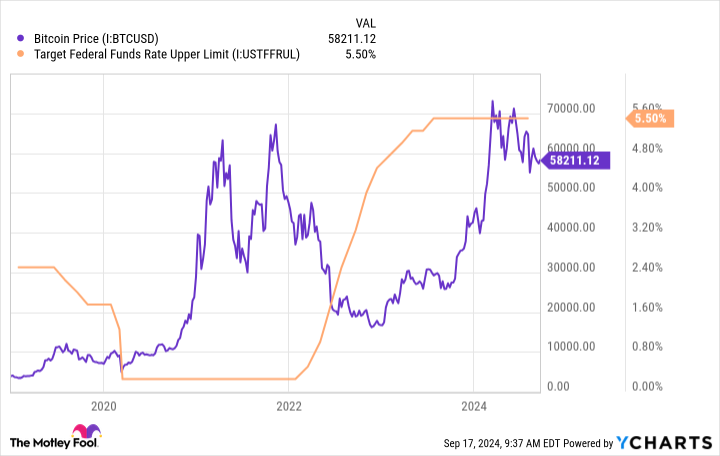Insider Unloading: Liberty Broadband Corp Sells $14.28M Worth Of Charter Communications Shares
Liberty Broadband Corp, Board Member at Charter Communications CHTR, executed a substantial insider sell on September 17, according to an SEC filing.
What Happened: After conducting a thorough analysis, Corp sold 40,027 shares of Charter Communications. This information was disclosed in a Form 4 filing with the U.S. Securities and Exchange Commission on Tuesday. The total transaction value is $14,275,229.
Charter Communications shares are trading down 0.19% at $338.69 at the time of this writing on Wednesday morning.
Get to Know Charter Communications Better
Charter is the product of the 2016 merger of three cable companies, each with a decades-long history in the business: Legacy Charter, Time Warner Cable, and Bright House Networks. The firm now holds networks capable of providing television, internet access, and phone services to roughly 58 million US homes and businesses, around 40% of the country. Across this footprint, Charter serves 30 million residential and 2 million commercial customer accounts under the Spectrum brand, making it the second-largest US cable company behind Comcast. The firm also owns, in whole or in part, sports and news networks, including Spectrum SportsNet (long-term local rights to Los Angeles Lakers games), SportsNet LA (Los Angeles Dodgers), SportsNet New York (New York Mets), and Spectrum News NY1.
Charter Communications: A Financial Overview
Revenue Growth: Charter Communications displayed positive results in 3 months. As of 30 June, 2024, the company achieved a solid revenue growth rate of approximately 0.19%. This indicates a notable increase in the company’s top-line earnings. When compared to others in the Communication Services sector, the company excelled with a growth rate higher than the average among peers.
Analyzing Profitability Metrics:
-
Gross Margin: The company shows a low gross margin of 40.28%, suggesting potential challenges in cost control and profitability compared to its peers.
-
Earnings per Share (EPS): The company excels with an EPS that surpasses the industry average. With a current EPS of 8.58, Charter Communications showcases strong earnings per share.
Debt Management: Charter Communications’s debt-to-equity ratio stands notably higher than the industry average, reaching 7.58. This indicates a heavier reliance on borrowed funds, raising concerns about financial leverage.
Valuation Metrics:
-
Price to Earnings (P/E) Ratio: Charter Communications’s stock is currently priced at a premium level, as reflected in the higher-than-average P/E ratio of 10.83.
-
Price to Sales (P/S) Ratio: The P/S ratio of 0.92 is lower than the industry average, implying a discounted valuation for Charter Communications’s stock in relation to sales performance.
-
EV/EBITDA Analysis (Enterprise Value to its Earnings Before Interest, Taxes, Depreciation & Amortization): With an EV/EBITDA ratio of 6.94, the company’s market valuation exceeds industry averages.
Market Capitalization Analysis: The company exhibits a lower market capitalization profile, positioning itself below industry averages. This suggests a smaller scale relative to peers.
Now trade stocks online commission free with Charles Schwab, a trusted and complete investment firm.
Understanding the Significance of Insider Transactions
Insider transactions shouldn’t be used primarily to make an investing decision, however an insider transaction can be an important factor in the investing decision.
From a legal standpoint, the term “insider” pertains to any officer, director, or beneficial owner holding more than ten percent of a company’s equity securities as outlined in Section 12 of the Securities Exchange Act of 1934. This encompasses executives in the c-suite and significant hedge funds. These insiders are mandated to inform the public of their transactions through a Form 4 filing, to be submitted within two business days of the transaction.
A company insider’s new purchase is a indicator of their positive anticipation for a rise in the stock.
While insider sells may not necessarily reflect a bearish view and can be motivated by various factors.
A Closer Look at Important Transaction Codes
Examining transactions, investors often concentrate on those unfolding in the open market, meticulously detailed in Table I of the Form 4 filing. A P in Box 3 denotes a purchase, while S signifies a sale. Transaction code C indicates the conversion of an option, and transaction code A denotes a grant, award, or other acquisition of securities from the company.
Check Out The Full List Of Charter Communications’s Insider Trades.
This article was generated by Benzinga’s automated content engine and reviewed by an editor.
Market News and Data brought to you by Benzinga APIs
© 2024 Benzinga.com. Benzinga does not provide investment advice. All rights reserved.
RBC Bearings Insider Trades Send A Signal
Disclosed on September 17, MICHAEL HARTNETT, President and CEO at RBC Bearings RBC, executed a substantial insider sell as per the latest SEC filing.
What Happened: After conducting a thorough analysis, HARTNETT sold 30,624 shares of RBC Bearings. This information was disclosed in a Form 4 filing with the U.S. Securities and Exchange Commission on Tuesday. The total transaction value is $8,841,707.
During Wednesday’s morning session, RBC Bearings shares down by 0.18%, currently priced at $289.96.
Get to Know RBC Bearings Better
RBC Bearings Inc is an international manufacturer and marketer of highly engineered precision bearings, components and essential systems for the industrial, defense and aerospace industries. The offering includes plain bearings, roller bearings, ball bearings, and engineered products. The end market is the United States of America. The company has two reportable segments: Aerospace Defense segment represents the end markets for the company’s highly engineered bearings and precision components used in commercial aerospace, defense aerospace, and sea and ground defense applications; and Industrial segment represents the end markets for the company’s engineered bearings and precision components used in various industrial applications. It derives maximum revenue from Industrial Segment.
Financial Milestones: RBC Bearings’s Journey
Revenue Growth: RBC Bearings’s remarkable performance in 3 months is evident. As of 30 June, 2024, the company achieved an impressive revenue growth rate of 4.96%. This signifies a substantial increase in the company’s top-line earnings. When compared to others in the Industrials sector, the company excelled with a growth rate higher than the average among peers.
Analyzing Profitability Metrics:
-
Gross Margin: The company sets a benchmark with a high gross margin of 45.29%, reflecting superior cost management and profitability compared to its peers.
-
Earnings per Share (EPS): The company excels with an EPS that surpasses the industry average. With a current EPS of 1.92, RBC Bearings showcases strong earnings per share.
Debt Management: With a below-average debt-to-equity ratio of 0.42, RBC Bearings adopts a prudent financial strategy, indicating a balanced approach to debt management.
Exploring Valuation Metrics Landscape:
-
Price to Earnings (P/E) Ratio: RBC Bearings’s stock is currently priced at a premium level, as reflected in the higher-than-average P/E ratio of 42.78.
-
Price to Sales (P/S) Ratio: With a relatively high Price to Sales ratio of 5.38 as compared to the industry average, the stock might be considered overvalued based on sales performance.
-
EV/EBITDA Analysis (Enterprise Value to its Earnings Before Interest, Taxes, Depreciation & Amortization): With an EV/EBITDA ratio of 20.32, the company’s market valuation exceeds industry averages.
Market Capitalization Analysis: Falling below industry benchmarks, the company’s market capitalization reflects a reduced size compared to peers. This positioning may be influenced by factors such as growth expectations or operational capacity.
Now trade stocks online commission free with Charles Schwab, a trusted and complete investment firm.
The Relevance of Insider Transactions
Considering insider transactions is valuable, but it’s crucial to evaluate them in conjunction with other investment factors.
In legal terms, an “insider” refers to any officer, director, or beneficial owner of more than ten percent of a company’s equity securities registered under Section 12 of the Securities Exchange Act of 1934. This can include executives in the c-suite and large hedge funds. These insiders are required to let the public know of their transactions via a Form 4 filing, which must be filed within two business days of the transaction.
When a company insider makes a new purchase, that is an indication that they expect the stock to rise.
Insider sells, on the other hand, can be made for a variety of reasons, and may not necessarily mean that the seller thinks the stock will go down.
Navigating the World of Insider Transaction Codes
Taking a closer look at transactions, investors often prioritize those unfolding in the open market, meticulously cataloged in Table I of the Form 4 filing. A P in Box 3 denotes a purchase, while S signifies a sale. Transaction code C denotes the conversion of an option, and transaction code A signifies a grant, award, or other acquisition of securities from the company.
Check Out The Full List Of RBC Bearings’s Insider Trades.
This article was generated by Benzinga’s automated content engine and reviewed by an editor.
Market News and Data brought to you by Benzinga APIs
© 2024 Benzinga.com. Benzinga does not provide investment advice. All rights reserved.
Insider Unloading: Marguerite Nader Sells $2.49M Worth Of Equity Lifestyle Props Shares
Marguerite Nader, President and CEO at Equity Lifestyle Props ELS, reported an insider sell on September 17, according to a new SEC filing.
What Happened: Nader’s recent move involves selling 33,000 shares of Equity Lifestyle Props. This information is documented in a Form 4 filing with the U.S. Securities and Exchange Commission on Tuesday. The total value is $2,492,160.
Equity Lifestyle Props‘s shares are actively trading at $74.23, experiencing a down of 0.3% during Wednesday’s morning session.
Delving into Equity Lifestyle Props’s Background
Equity Lifestyle Properties is a residential REIT that focuses on owning manufactured housing, residential vehicle communities, and marinas. The company currently has a portfolio of 451 properties across the U.S. with a higher concentration in the Sunbelt region with 38% of the company’s properties located in Florida, 12% in Arizona, and 8% in California. Equity Lifestyle targets owning properties in attractive retirement destinations with over 70% of the company’s properties either being age-restricted or having an average resident age over 55.
Equity Lifestyle Props: Financial Performance Dissected
Revenue Growth: Equity Lifestyle Props’s revenue growth over a period of 3 months has been noteworthy. As of 30 June, 2024, the company achieved a revenue growth rate of approximately 2.65%. This indicates a substantial increase in the company’s top-line earnings. In comparison to its industry peers, the company trails behind with a growth rate lower than the average among peers in the Real Estate sector.
Key Profitability Indicators:
-
Gross Margin: The company shows a low gross margin of 48.45%, indicating concerns regarding cost management and overall profitability relative to its industry counterparts.
-
Earnings per Share (EPS): Equity Lifestyle Props’s EPS is a standout, portraying a positive bottom-line trend that exceeds the industry average with a current EPS of 0.42.
Debt Management: Equity Lifestyle Props’s debt-to-equity ratio stands notably higher than the industry average, reaching 2.41. This indicates a heavier reliance on borrowed funds, raising concerns about financial leverage.
Valuation Overview:
-
Price to Earnings (P/E) Ratio: Equity Lifestyle Props’s P/E ratio of 38.78 is below the industry average, suggesting the stock may be undervalued.
-
Price to Sales (P/S) Ratio: With a higher-than-average P/S ratio of 10.17, Equity Lifestyle Props’s stock is perceived as being overvalued in the market, particularly in relation to sales performance.
-
EV/EBITDA Analysis (Enterprise Value to its Earnings Before Interest, Taxes, Depreciation & Amortization): A high EV/EBITDA ratio of 24.51 reflects market recognition of Equity Lifestyle Props’s value, positioning it as more highly valued compared to industry peers.
Market Capitalization Analysis: The company’s market capitalization is below the industry average, suggesting that it is relatively smaller compared to peers. This could be due to various factors, including perceived growth potential or operational scale.
Now trade stocks online commission free with Charles Schwab, a trusted and complete investment firm.
The Impact of Insider Transactions on Investments
Insider transactions serve as a piece of the puzzle in investment decisions, rather than the entire picture.
In legal terms, an “insider” refers to any officer, director, or beneficial owner of more than ten percent of a company’s equity securities registered under Section 12 of the Securities Exchange Act of 1934. This can include executives in the c-suite and large hedge funds. These insiders are required to let the public know of their transactions via a Form 4 filing, which must be filed within two business days of the transaction.
When a company insider makes a new purchase, that is an indication that they expect the stock to rise.
Insider sells, on the other hand, can be made for a variety of reasons, and may not necessarily mean that the seller thinks the stock will go down.
Unlocking the Meaning of Transaction Codes
For investors, a primary focus lies on transactions occurring in the open market, as indicated in Table I of the Form 4 filing. A P in Box 3 denotes a purchase, while S signifies a sale. Transaction code C signals the conversion of an option, and transaction code A denotes a grant, award, or other acquisition of securities from the company.
Check Out The Full List Of Equity Lifestyle Props’s Insider Trades.
This article was generated by Benzinga’s automated content engine and reviewed by an editor.
Market News and Data brought to you by Benzinga APIs
© 2024 Benzinga.com. Benzinga does not provide investment advice. All rights reserved.
Prediction: These 3 Stocks Won't Be Magnificent Buys in 5 Years
The “Magnificent Seven” are a group of the world’s most popular and promising growth stocks. Investing in these big-name tech stocks has been a great way to earn some significant returns in recent years. But things can change quickly in the tech world, and just because some stocks have done well in recent years doesn’t mean that they will be solid stocks to hang on to in the long run.
Three Magnificent Seven stocks that I don’t think will look so magnificent in five years are Alphabet (NASDAQ: GOOG)(NASDAQ: GOOGL), Meta Platforms (NASDAQ: META), and Tesla (NASDAQ: TSLA). Here’s why these particular stocks could struggle in the years ahead.
1. Alphabet
Alphabet used to be a stock I was bullish about. The business looked dominant with a top video streaming website (YouTube) and a top search engine (Google).
Nowadays, I’m not as optimistic. As the ads get longer and longer on YouTube, the risk is that it might give users an incentive to switch to a streaming service such as Netflix instead, where there’s a broad range of top content to choose from to help justify its price tag without annoying ads (depending on the subscription tier).
But the biggest risk for Alphabet undoubtedly comes in its search business. Regulators have already ruled that Google is a monopoly, and the consequences of that are still unknown, but they’ll likely hurt its growth prospects. And with more artificial intelligence (AI)-powered chatbots answering questions and reducing the need to go to Google, that’s another headwind for its sales growth.
The stock might look cheap, trading at just 23 times its trailing earnings, and its revenue is still strong, growing by 14% year over year in the latest reported quarter, but investors shouldn’t gloss over the long-term risks that Alphabet faces. There could be some daunting new challenges and competition that could stunt its growth and reduce its earnings power, which is why I would avoid the stock right now.
2. Meta Platforms
Another business that’s doing well right now but could struggle in the future is Meta Platforms. Business has been booming for the company: Revenue jumped 22% year over year in the June quarter, totaling $39.1 billion. Meta management says its AI assistant will be “the most used AI assistant in the world by the end of the year.”
The present looks solid, but the future might not be as promising. Like Alphabet, Meta faces challenges from regulators. Concerns relating to the company’s social media platforms and their alleged adverse mental health effects on users might lead to changes in Meta’s operations that could impact the bottom line. Last year, 42 state attorneys general sued Meta, claiming that Facebook and Instagram were too addictive for young kids. Elsewhere, greater restrictions are being called for on the data Meta collects and how it collects it. The social media platforms it operates could become less valuable for advertisers if the restrictions are added.
Then there is the continued massive spending by Meta on its Reality Labs segment and a metaverse that is showing little sign of ever providing the return on investment needed to justify it.
At 27 times earnings, Meta’s stock doesn’t look too expensive, but that could change if its growth slows down while the spending remains high. This is a tech stock I would avoid — it could have a long way to fall in the next few years.
3. Tesla
The most expensive stock on this list (based on valuation) is Tesla; investors are paying more than 60 times earnings to buy shares in it. But that isn’t uncommon for the electric vehicle (EV) maker. Investors are accustomed to paying high multiples for the stock. This year, however, hasn’t been a great one — the stock is down around 7%.
Investors are concerned about the company’s thinning margins due to a rise in competition and weak consumer demand. Neither one of those issues might improve anytime soon. A possible recession could hurt demand in the short term, and while that might be temporary, growing competition from Chinese EV makers could lead to Tesla needing to further reduce its prices, which would only exacerbate worries about its bottom line.
Tesla hopes that a successful launch of its robotaxi program could be a catalyst, but that could prove to be an underwhelming development for the company given the potential for regulatory issues and other obstacles.
As challenging as conditions are for Tesla right now, they could get worse for the stock over the next five years.
Should you invest $1,000 in Alphabet right now?
Before you buy stock in Alphabet, consider this:
The Motley Fool Stock Advisor analyst team just identified what they believe are the 10 best stocks for investors to buy now… and Alphabet wasn’t one of them. The 10 stocks that made the cut could produce monster returns in the coming years.
Consider when Nvidia made this list on April 15, 2005… if you invested $1,000 at the time of our recommendation, you’d have $708,348!*
Stock Advisor provides investors with an easy-to-follow blueprint for success, including guidance on building a portfolio, regular updates from analysts, and two new stock picks each month. The Stock Advisor service has more than quadrupled the return of S&P 500 since 2002*.
*Stock Advisor returns as of September 16, 2024
Suzanne Frey, an executive at Alphabet, is a member of The Motley Fool’s board of directors. Randi Zuckerberg, a former director of market development and spokeswoman for Facebook and sister to Meta Platforms CEO Mark Zuckerberg, is a member of The Motley Fool’s board of directors. David Jagielski has no position in any of the stocks mentioned. The Motley Fool has positions in and recommends Alphabet, Meta Platforms, Netflix, and Tesla. The Motley Fool has a disclosure policy.
Prediction: These 3 Stocks Won’t Be Magnificent Buys in 5 Years was originally published by The Motley Fool
Analyst Report: BHP Group Limited
Analyst Profile
John Eade
President & Director of Portfolio Strategies
John is chairman and CEO of Argus Research Group and president of Argus Research Company. Over the years, his responsibilities at Argus have included chairing the Investment Policy Committee as then director of research; helping form the firm’s overall investment strategy; writing a weekly investment column; and authoring the flagship Portfolio Selector report. He has also provided coverage of the Healthcare, Financial and Consumer sectors. John has been with Argus since 1989. He has an MBA in Finance from New York University’s Stern School of Business and a Bachelor’s degree in Journalism from Northwestern University’s Medill School of Journalism. He has been interviewed and quoted extensively in The New York Times, Forbes, Time, Fortune and Money magazines, and has been a frequent guest on CNBC, CNN, CBS News, ABC News and the Bloomberg Radio and Television networks. John is a founder and board member of the Investorside Research Association, an industry trade organization. He is also a member of the New York Society of Security Analysts and the CFA Institute.
argenx Announces Publication in The Lancet Neurology of Pivotal ADHERE Study Data in Chronic Inflammatory Demyelinating Polyneuropathy
ADHERE was largest and most innovative clinical trial of CIDP patients to date
VYVGART® Hytrulo (efgartigimod alfa and hyaluronidase-qvfc) demonstrated reduction in disease progression, reduced risk of relapse and rapid onset of action
VYVGART Hytrulo is first and only neonatal Fc receptor (FcRn) blocker FDA-approved to treat CIDP
September 19, 2024 – 7:00 am CET
Amsterdam, the Netherlands – argenx SE ((Euronext &, NASDAQ:ARGX), a global immunology company committed to improving the lives of people suffering from severe autoimmune diseases, today announced publication in The Lancet Neurology of the pivotal ADHERE Study, the largest clinical trial to date in chronic inflammatory demyelinating polyneuropathy (CIDP). CIDP is a rare, debilitating, often progressive, immune-mediated neuromuscular disorder of the peripheral nervous system. This is the first time the ADHERE Study has been published in a peer-reviewed medical journal. A link to the full manuscript can be found here.
“Since its approval in June, VYVGART Hytrulo is already transforming the lives of patients with CIDP,” said Luc Truyen, M.D., Ph.D., Chief Medical Officer of argenx. “With today’s publication in The Lancet Neurology, we are also advancing scientific knowledge of the disease biology underlying CIDP and thereby helping to progress further innovation with the potential, like VYVGART Hytrulo, to significantly improve function for patients while easing the burdens associated with prior treatments.”
Highlights from the ADHERE study:
- ADHERE met its primary endpoint (p<0.0001) demonstrating a 61% reduction (HR: 0.39 95% CI: 0.25; 0.61) in the risk of relapse versus placebo
- 69% (221/322) of patients treated with VYVGART Hytrulo, regardless of prior treatment, demonstrated evidence of clinical improvement, including improvements in mobility, function and strength
- 99% of trial participants elected to participate in the ADHERE open-label extension
- VYVGART Hytrulo was well-tolerated and safety results were consistent with the known safety profile of VYVGART in previous clinical studies and real-world use
The ADHERE data demonstrate that VYVGART Hytrulo has a rapid onset of action, and can reduce CIDP disease progression and risk of relapse:
- Reduced risk of relapse: VYVGART Hytrulo reduced the risk of relapse by 61% as assessed by aINCAT deterioration (Stage B primary endpoint) versus placebo (HR 0.394 [95% CI 0.253–0.614]; p<0.0001).
- Reduced disease progression: VYVGART Hytrulo reduced the risk of CIDP disease progression based on time-to-first ≥4-point decrease in I-RODS score compared with Stage B baseline (HR 0.537 [95% CI 0.354–0.814]; nominal p=0.0034).
- Rapid onset of action: In Stage A, time to first improvement on aINCAT, I-RODS, or grip strength scores among the 25th percentile of patients was 9.0 days (95% CI 8.0-9.0) after the first dose of VYVGART Hytrulo; the median estimate was 22.0 days (15.0-23.0).
In June 2024, the U.S. Food and Drug Administration approved VYVGART Hytrulo for the treatment of adult patients with CIDP. VYVGART Hytrulo is also approved for the treatment of generalized myasthenia gravis (gMG) in adult patients who are anti-acetylcholine receptor (AChR) antibody positive.
See FDA-approved Important Safety Information below and full Prescribing Information for VYVGART Hytrulo for additional information.
What is VYVGART® HYTRULO (efgartigimod alfa and hyaluronidase-qvfc)?
VYVGART HYTRULO is a prescription medicine used for the treatment of adult patients with chronic inflammatory demyelinating polyneuropathy (CIDP).
IMPORTANT SAFETY INFORMATION
Do not use VYVGART HYTRULO if you have a serious allergy to efgartigimod alfa, hyaluronidase, or any of the other ingredients in VYVGART HYTRULO. VYVGART HYTRULO can cause serious allergic reactions and a decrease in blood pressure leading to fainting.
VYVGART HYTRULO may cause serious side effects, including:
Infection. VYVGART HYTRULO may increase the risk of infection. The most common infections for efgartigimod alfa-fcab-treated patients were urinary tract and respiratory tract infections. Signs or symptoms of an infection may include fever, chills, frequent and/or painful urination, cough, pain and blockage of nasal passages/sinus, wheezing, shortness of breath, fatigue, sore throat, excess phlegm, nasal discharge, back pain, and/or chest pain.
Allergic Reactions (hypersensitivity reactions). VYVGART HYTRULO can cause allergic reactions such as rashes, swelling under the skin, and shortness of breath. Hives were also observed in patients treated with VYVGART HYTRULO. Serious allergic reactions, such as trouble breathing and decrease in blood pressure leading to fainting have been reported with efgartigimod alfa-fcab.
Infusion-Related Reactions. VYVGART HYTRULO can cause infusion-related reactions. The most frequent symptoms and signs reported with efgartigimod alfa-fcab were high blood pressure, chills, shivering, and chest, abdominal, and back pain.
Tell your doctor if you have signs or symptoms of an infection, allergic reaction, or infusion-related reaction. These can happen while you are receiving your VYVGART HYTRULO treatment or afterward. Your doctor may need to pause or stop your treatment. Contact your doctor immediately if you have signs or symptoms of a serious allergic reaction.
Before taking VYVGART HYTRULO, tell your doctor if you:
- take any medicines, including prescription and non-prescription medicines, supplements, or herbal medicines,
- have received or are scheduled to receive a vaccine (immunization), or
- have any allergies or medical conditions, including if you are pregnant or planning to become pregnant, or are breastfeeding.
- What are the common side effects of VYVGART HYTRULO?
The most common side effects in efgartigimod-alfa-fcab-treated patients were respiratory tract infection, headache, and urinary tract infection. Additional common side effects with VYVGART HYTRULO are injection site reactions, including rash, redness of the skin, itching sensation, bruising, pain, and hives.
These are not all the possible side effects of VYVGART HYTRULO. Call your doctor for medical advice about side effects. You may report side effects to the US Food and Drug Administration at 1-800-FDA-1088.
Please see the full Prescribing Information for VYVGART HYTRULO and talk to your doctor.
About ADHERE Trial Design
The ADHERE trial was a multicenter, randomized, double-blind, placebo-controlled trial evaluating VYVGART® Hytrulo (efgartigimod alfa and hyaluronidase-qvfc) for the treatment of chronic inflammatory demyelinating polyneuropathy (CIDP). ADHERE enrolled 322 adult patients with CIDP who were treatment naïve (not on active treatment within the past six months or newly diagnosed) or being treated with immunoglobulin therapy or corticosteroids. The trial consisted of an open-label Stage A followed by a randomized, placebo-controlled Stage B. In order to be eligible for the trial, the diagnosis of CIDP was confirmed by an independent panel of experts. Patients entered a run-in stage, where any ongoing CIDP treatment was stopped and in order to be eligible for Stage A had to demonstrate active disease, with clinically meaningful worsening on at least one CIDP clinical assessment tool, including INCAT, I-RODS, or mean grip strength. Treatment naïve patients were able to skip the run-in period with proof of recent worsening. To advance to Stage B, patients needed to demonstrate evidence of clinical improvement (ECI) with VYVGART Hytrulo. ECI was achieved through improvement of the INCAT score, or improvement on I-RODS or mean grip strength if those scales had demonstrated worsening during the run-in period. In Stage B, patients were randomized to either VYVGART Hytrulo or placebo for up to 48 weeks. The primary endpoint was measured once 88 total relapses or events were achieved in Stage B and was based on the hazard ratio for the time to first adjusted INCAT deterioration (i.e. relapse). After Stage B, all patients had the option to roll-over to an open-label extension study to receive VYVGART Hytrulo.
About VYVGART Hytrulo (efgartigimod alfa and hyaluronidase-qvfc)
VYVGART Hytrulo is a subcutaneous combination of efgartigimod alfa, a human IgG1 antibody fragment marketed for intravenous use as VYVGART, and recombinant human hyaluronidase PH20 (rHuPH20), Halozyme’s ENHANZE® drug delivery technology to facilitate subcutaneous injection delivery of biologics. In binding to the neonatal Fc receptor (FcRn), VYVGART Hytrulo results in the reduction of circulating IgG. It is the first-and-only approved FcRn blocker administered by subcutaneous injection.
About Chronic Inflammatory Demyelinating Polyneuropathy
Chronic inflammatory demyelinating polyneuropathy (CIDP) is a rare and serious autoimmune disease of the peripheral nervous system. Although confirmation of disease pathophysiology is still emerging, there is increasing evidence that IgG antibodies play a key role in the damage to the peripheral nerves. People with CIDP experience fatigue, muscle weakness and a loss of feeling in their arms and legs that can get worse over time or may come and go. These symptoms can significantly impair a person’s ability to function in their daily lives. Without treatment, one-third of people living with CIDP will need a wheelchair. There are approximately 24,000 patients in the U.S. currently receiving treatment for CIDP.
About argenx
argenx is a global immunology company committed to improving the lives of people suffering from severe autoimmune diseases. Partnering with leading academic researchers through its Immunology Innovation Program (IIP), argenx aims to translate immunology breakthroughs into a world-class portfolio of novel antibody-based medicines. argenx developed and is commercializing the first approved neonatal Fc receptor (FcRn) blocker in the U.S., Japan, Israel, the EU, the UK, Canada and China. The Company is evaluating efgartigimod in multiple serious autoimmune diseases and advancing several earlier stage experimental medicines within its therapeutic franchises. For more information, visit www.argenx.com and follow us on LinkedIn, X/Twitter, Instagram, Facebook, and YouTube.
Contacts
Media:
Ben Petok
bpetok@argenx.com
Investors:
Alexandra Roy (US)
aroy@argenx.com
Lynn Elton (EU)
lelton@argenx.com

© 2024 Benzinga.com. Benzinga does not provide investment advice. All rights reserved.
Cathie Wood's Ark Invest Continues Dumping Robinhood And Palantir Shares As Interest Rates Fall
On Wednesday, Cathie Wood-led Ark Invest continued its trend of offloading shares of Robinhood Markets Inc HOOD and Palantir Technologies Inc PLTR, marking significant trades for the day.
The Robinhood Trade: Ark Invest’s Ark Fintech Innovation ETF ARKF sold 24,796 shares of Robinhood. This decision aligns with Ark’s recent trading patterns, which have seen a steady decrease in Robinhood holdings.
The move comes in the wake of Robinhood’s $3.9 million settlement with California’s Department of Justice over its previous ban on Bitcoin BTC/USD withdrawals. Despite this setback, Robinhood has been evolving from a meme stock trading platform to a serious contender against traditional brokerages. The value of the trade, based on Robinhood’s closing price of $22.95 on the same day, is approximately $569,368.
Notably, Robinhood shares rose after the Federal Reserve cut interest rates by 50 basis points, benefiting from increased user engagement, margin trading, and favorable growth stock valuations in a low-rate environment. The shares appreciated 1.4% in the regular session and gained 0.9% in the after-hours trading.
The Palantir Trade: Ark Invest’s ARK Innovation ETF ARKK fund sold 32,772 shares of Palantir. This move followed the company’s 5th AIPCon, where CEO Alex Karp expressed optimism about Palantir’s inclusion in the S&P 500 Index and the company’s potential for growth. Based on Palantir’s closing price of $36.38 on the same day, the value of the trade is approximately $1.2 million.
Other Key Trades:
- Ark Invest sold shares of Veeva Systems Inc. The firm also offloaded shares of Butterfly Network Inc.
- Ark Invest bought shares of Tempus AI Inc and sold shares of Roblox Corp.
- Ark Invest fund sold shares of Intuitive Surgical Inc and bought shares of 3D Systems Corp.
Read Next:
Market News and Data brought to you by Benzinga APIs
© 2024 Benzinga.com. Benzinga does not provide investment advice. All rights reserved.
Billionaires Are Buying This Cryptocurrency That Could Soar 116% by Year's End, According to This Analyst
Bitcoin (CRYPTO: BTC) can be a volatile asset. But that hasn’t stopped some analysts, experts, and billionaires from turning extremely bullish on the world’s largest cryptocurrency and buying huge amounts of it. After recent purchases the other day, billionaire Michael Saylor’s company MicroStrategy Incorporated owned 1.17% of all Bitcoin outstanding. Other billionaires, including Elon Musk and the Winklevoss twins, have also purchased huge amounts of Bitcoin.
These billionaires seem to be in line with one Wall Street analyst who recently issued a research note suggesting the price of Bitcoin could jump 116% from current levels and hit $125,000 by year’s end. Let’s take a look.
Impact of the election
In a recent report by the investment bank Standard Chartered, a team of analysts said that Bitcoin is poised to hit a new high by the end of the year, which is only a few months away. The bank considered several economic and political factors in reaching this conclusion.
First, Standard Chartered looked at how the presidential election might affect Bitcoin, ultimately determining that the outcome is less important than people think.
“Progress on relaxing regulations — particularly the repeal of SAB 121, which imposes stringent accounting rules on banks’ digital asset holdings — will continue in 2025 no matter who is in the White House,” Geoff Kendrick, global head of digital assets research at Standard Chartered, wrote in his note. Still, Kendrick thinks crypto deregulation will move faster if former President Donald Trump wins rather Vice President Kamala Harris, although he still thinks it would eventually happen under a Harris presidency, too.
Kendrick believes that a Harris victory would likely lead to an initial decrease in the price of Bitcoin but that it wouldn’t last long due to other external factors. Kendrick assigned Bitcoin a $125,000 price target if Trump wins and a $75,000 price target if Harris wins.
The economic impact
Aside from the election, Kendrick also thinks Bitcoin will start “building positive momentum” as the yield curve un-inverts after more than two years and starts to steepen, with long-term yields exceeding short-term yields.
That certainly makes sense from a historical perspective because Bitcoin has performed well in falling-interest-rate environments, which tend to increase investment in riskier assets because Treasury bills no longer yield as much. Additionally, lower interest rates typically result in a weaker U.S. dollar, creating another environment in which Bitcoin has performed well because it is viewed as an alternative to traditional currencies like the dollar.
Bitcoin Price data by YCharts
As you can see above, Bitcoin has performed very well in a lower-interest-rate environment. Recently, it’s also been resilient in the higher-rate environment.
Bitcoin and price targets
Price targets are difficult to predict for even the oldest blue-chip stocks, but they are especially difficult for an asset like Bitcoin, which can be more volatile than a traditional stock. We are also still in the process of learning more about Bitcoin and other cryptocurrencies.
Now, the billionaires who own Bitcoin have predicted some pretty outlandish price targets. For instance, Saylor thinks the price of Bitcoin could hit $13 million by 2045. Maybe, but it seems like an aggressive call. The good news about price targets from Wall Street is that they are usually placed 12 to 18 months out and are therefore a little more realistic.
I couldn’t tell you whether Bitcoin will hit $75,000 or $125,000 by year’s end. But I do think Bitcoin has long-term upside and can be a part of your portfolio.
Should you invest $1,000 in Bitcoin right now?
Before you buy stock in Bitcoin, consider this:
The Motley Fool Stock Advisor analyst team just identified what they believe are the 10 best stocks for investors to buy now… and Bitcoin wasn’t one of them. The 10 stocks that made the cut could produce monster returns in the coming years.
Consider when Nvidia made this list on April 15, 2005… if you invested $1,000 at the time of our recommendation, you’d have $708,348!*
Stock Advisor provides investors with an easy-to-follow blueprint for success, including guidance on building a portfolio, regular updates from analysts, and two new stock picks each month. The Stock Advisor service has more than quadrupled the return of S&P 500 since 2002*.
*Stock Advisor returns as of September 16, 2024
Bram Berkowitz has a position in Bitcoin. The Motley Fool has positions in and recommends Bitcoin. The Motley Fool recommends Standard Chartered Plc. The Motley Fool has a disclosure policy.
Billionaires Are Buying This Cryptocurrency That Could Soar 116% by Year’s End, According to This Analyst was originally published by The Motley Fool
The stock market dipped after a historic Fed rate cut. Here’s what the experts think
The Federal Reserve gave investors exactly what they said they wanted on Wednesday, slashing interest rates by an outsized 50 basis points—but it still wasn’t enough. After a brief jump following the initial announcement, stocks went through a period of highly volatile trading before all three major U.S. market indices ended Wednesday lower.
The Dow Jones Industrial Average sank 0.25%, while the S&P 500 and the tech-heavy Nasdaq Composite sank 0.29%, and 0.31%, respectively.
Markets were selling off even as Fed Chair Jerome Powell told reporters at his post-FOMC meeting press conference that the 50 basis point rate cut was meant to demonstrate officials’ “confidence” that current labor market strength can continue with an “appropriate recalibration” of monetary policy.
While no one can know the definitive reason behind stocks’ negative reaction to what should have been a market-juicing mega rate cut, Rick Rieder, BlackRock’s CIO of Global Fixed Income and Head of the BlackRock Global Allocation Investment Team, touched on one theory.
Looking at the Fed’s Summary of Economic Projections, Rieder noted that Fed officials penciled two more 25 basis point rate cuts this year, and another 100 basis points of cuts in 2025. That’s a lot, but it’s not what investors were pricing in prior to the meeting.
“The market has priced in a rate path that looks more like what an impending recession would require…versus the recalibration of rates to a less restrictive, or neutral, policy evolution, which is what we think this cycle likely represents,” he told Fortune via email.
Essentially, even though markets got their juicy 50 basis point rate cut in the near-term, the longer-term outlook for interest rates from Fed officials wasn’t as appealing as anticipated.
Thomas Simons, a senior economist at the investment bank Jefferies, echoed this outlook in a note to clients Wednesday. “The long-run rate continues to be revised up, implying a higher terminal rate. The 50 [basis point] cut today was a dovish surprise, but we do not see signs that more big cuts are coming,” he said.
The economy is ‘fine’ and ‘we’re not behind’
There’s another potential reason underlying stocks’ negative reaction to the Fed’s Wednesday decision. Some see Fed officials’ outsized rate cut as a sign that they’ve recognized they should have begun cutting rates months ago.
Powell addressed these concerns in his press conference Wednesday. “We don’t think we’re behind….You can take this as a sign of our commitment not to get behind,” he told reporters.
But more than a few experts just aren’t buying it. “This is a Fed that believes they are behind the curve,” Robert Minter, director of ETF Investment Strategy at abrdn, told Fortune via email.
The skepticism isn’t without reason. Even Powell himself admitted that if Fed officials would have seen July’s weak jobs report prior to that month’s FOMC meeting, they likely would have cut rates then. “If we’d have gotten the July [jobs] report before the meeting, would we have cut? We might well have,” he said. “We didn’t make that decision. But you know we might well have.”
Robert Frick, corporate economist at Navy Federal Credit Union, even argued that the Fed may be concerned that labor market data isn’t as dependable as they imagined after revisions to previous jobs data showed the U.S. economy employed 818,000 fewer people between March 2023 and March 2024 than originally reported.
“The half point cut is an admission the Fed is behind the curve, but not a sign of panic,” Frick told Fortune via email. “The Fed has been ‘data driven,’ but doubts about that data have proven on point as it didn’t paint an accurate picture of the labor market.”
“With inflation all but whipped, the Fed needs to quickly improve conditions for hiring and spur investment to create more jobs,” he added.
Once again, however, Powell attempted to address concerns about labor market and economic weakness during his press conference.
“The U.S. economy is in good shape,” he said. “It’s growing at a solid pace. Inflation is down. The labor market is in a strong place. We want to keep it there. That’s what we’re doing.”
“I don’t see anything in the economy right now that suggests the likelihood of a recession—sorry, of a downturn—is elevated,” he added.
Some experts celebrated Powell’s decision to opt for a 50 basis point rate cut as well. “For the first time since the Pandemic, this Fed made an aggressive action to be ahead of the curve by cutting rates to ensure the economy does not slip into recession,” Jay Hatfield, CEO of Infrastructure Capital Advisors, told Fortune via email.
It was perhaps this difference of opinion among various experts that led to the volatile trading seen on Wednesday. Citi Wealth’s interim chief investment officer Steven Wieting warned this could happen prior to the Fed’s announcement, noting that volatility is common as investors’ digest Fed decisions and their myriad of potential implications.
There was also one more, potentially market suppressing, comment that Powell offered on Wednesday.
When it comes to the future outlook for the neutral rate—the level where monetary policy becomes neither stimulative or accommodative—Powell said that he believes “we’re not going back” to the near-zero rates that became common prior to the pandemic.
“It feels to me that the neutral rate is probably significantly higher than it was back then,” he said.
With many investors looking for evidence of where interest rates might land, not just in the near-term but years from now, this comment could have exacerbated stocks’ sell-off.
This story was originally featured on Fortune.com
Badger Meter, Inc. Hit a 52 Week High, Can the Run Continue?
Have you been paying attention to shares of Badger Meter BMI? Shares have been on the move with the stock up 6% over the past month. The stock hit a new 52-week high of $215.94 in the previous session. Badger Meter has gained 38.4% since the start of the year compared to the 20.3% move for the Zacks Computer and Technology sector and the 11.1% return for the Zacks Instruments – Control industry.
What’s Driving the Outperformance?
The stock has an impressive record of positive earnings surprises, as it hasn’t missed our earnings consensus estimate in any of the last four quarters. In its last earnings report on July 19, 2024, Badger Meter reported EPS of $1.12 versus consensus estimate of $0.98 while it beat the consensus revenue estimate by 7.86%.
For the current fiscal year, Badger Meter is expected to post earnings of $4.09 per share on $821.88 million in revenues. This represents a 30.25% change in EPS on a 16.81% change in revenues. For the next fiscal year, the company is expected to earn $4.66 per share on $891.5 million in revenues. This represents a year-over-year change of 13.92% and 8.47%, respectively.
Valuation Metrics
Badger Meter may be at a 52-week high right now, but what might the future hold for the stock? A key aspect of this question is taking a look at valuation metrics in order to determine if the company has run ahead of itself.
On this front, we can look at the Zacks Style Scores, as they provide investors with an additional way to sort through stocks (beyond looking at the Zacks Rank of a security). These styles are represented by grades running from A to F in the categories of Value, Growth, and Momentum, while there is a combined VGM Score as well. The idea behind the style scores is to help investors pick the most appropriate Zacks Rank stocks based on their individual investment style.
Badger Meter has a Value Score of D. The stock’s Growth and Momentum Scores are B and B, respectively, giving the company a VGM Score of B.
In terms of its value breakdown, the stock currently trades at 52.3X current fiscal year EPS estimates, which is a premium to the peer industry average of 25.4X. On a trailing cash flow basis, the stock currently trades at 51.9X versus its peer group’s average of 20.7X. Additionally, the stock has a PEG ratio of 2.92. This isn’t enough to put the company in the top echelon of all stocks we cover from a value perspective.
Zacks Rank
We also need to look at the Zacks Rank for the stock, as this supersedes any trend on the style score front. Fortunately, Badger Meter currently has a Zacks Rank of #2 (Buy) thanks to favorable earnings estimate revisions from covering analysts.
Since we recommend that investors select stocks carrying Zacks Rank of 1 (Strong Buy) or 2 (Buy) and Style Scores of A or B, it looks as if Badger Meter meets the list of requirements. Thus, it seems as though Badger Meter shares could have potential in the weeks and months to come.
Market News and Data brought to you by Benzinga APIs
© 2024 Benzinga.com. Benzinga does not provide investment advice. All rights reserved.









